Quokka - The Happiest Animal on Earth
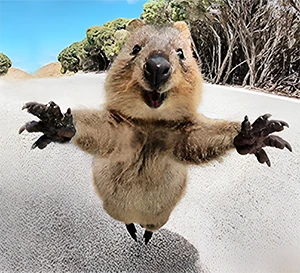
Contents
What Does a Quokka Look Like?
The quokka is a small, cat-sized marsupial with thick greyish-brown fur, a round face, short teddy bear ears, a black button nose, and bright, inquisitive eyes. With its irresistible cuddly teddy bear-like appearance, seemingly permanent smile, and friendly nature, it is often described as the “happiest animal in the world.”
Male quokkas are slightly larger than females, weighing between 2.5 and 5 kilograms and measuring 40 to 54 centimetres in length. As a member of the macropod family, which also includes kangaroos and wallabies, quokkas share familiar traits like short forelimbs with five clawed fingers for grasping and grooming and muscular hind legs for hopping.
How to Pronounce Quokka
'Quokka' is pronounced in several different ways. Some pronounce it kwo-ka (rhymes with "mocha"). But most people say kwah-ka (rhymes with "wokka").
The Quokka Selfie Craze

Photo: Quokka selfie
The quokka's cute smile and friendly personality have made it an internet sensation and the darling of selfie photographers. It has little fear of humans and approaches people quite readily. However, their adorable poses may be a clever trick—quokkas have learned that acting cute can earn them tasty handouts from humans.
Tip for Visitors: Feeding quokkas is harmful to their health. Stick to taking photos and letting them find their own food.
Quokka Social Life and Behaviour
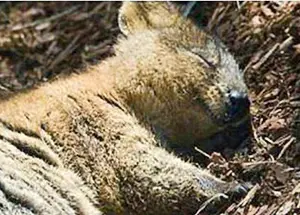
Photo: Quokka resting
Quokkas are highly social creatures and live in family groups of 20 to 150 members with overlapping home ranges. A dominant male leads these groups. Despite their laid-back reputation, male quokkas sometimes scuffle over prime resting spots.
Quokkas spend most of the day napping in the shade in dense vegetation. At dusk, they become more active, traveling along well-worn paths to forage for food.
Fun Fact: On Rottnest Island, quokkas have adjusted their routines to be active during the day because they have adapted to human feeding patterns.
Quokka Habitat
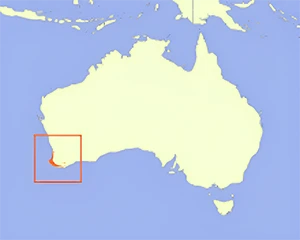
Photo: Quokka Habitat Map
Quokkas live in moist, dense scrubland on Rottnest Island and Bald Island off the coast of Western Australia (see map). A small population is also found on the Australian mainland in south-western Western Australia in vegetation around swamps and near watercourses.
What Do Quokkas Eat?
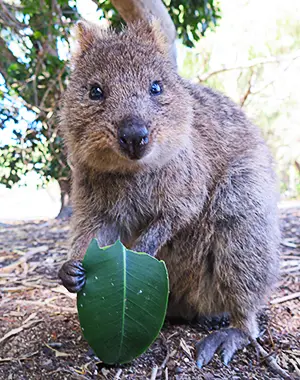
Photo: Quokka eating a leaf
Quokkas are browsing herbivores that mainly eat leaves, soft shoots, grasses, and succulents. Quokkas eat by biting off a piece of vegetation, stuffing it into their mouths, chopping it into small pieces, and swallowing it. They later regurgitate their food and chew it thoroughly before swallowing it again. (Similar to cattle chewing the cud).
On Rottnest Island, they have adapted to eating water-retaining succulents to survive the dry climate. These resourceful creatures store fat in their tails to help them through tough times when food is scarce.
Quokka Reproduction
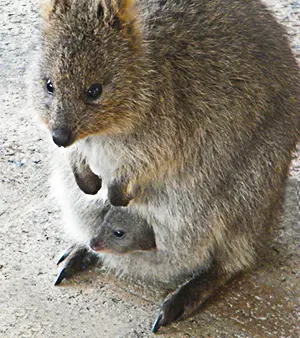
Photo: A female quokka with its joey
Female quokkas give birth to one joey at a time. When born, the tiny joey is less than 1cm long and weighs under 0.4 grams! It is born blind and hairless, with short forelimbs and undeveloped hind legs and tail. The newborn joey travels on its own to its mother’s pouch, crawling up her fur in a swimming (breaststroke) motion, which takes around three minutes. Once in the pouch, it continues to grow for about six months. Even after emerging from the pouch, the joey stays close to its mother for several more months before becoming fully independent.
Do Quokkas Throw Away Their Baby?
Can quokkas actually throw their babies at predators? The answer is no. Their arms are too short and not strong enough to do this.
However, female quokkas may use a clever biological strategy to escape a dangerous situation. If a predator threatens her, the mother may eject her offspring from her pouch. The abandoned baby draws the predator to the youngster on the ground, allowing the mother to escape. This ensures her survival, although it does mean sacrificing her young.
Are Quokkas Dangerous?
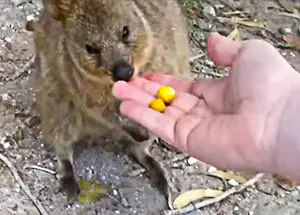
Photo: Don't feed the quokka. They may bite.
Despite their timid and gentle appearance, quokkas can defend themselves if provoked. When threatened, they first try to hop away or make loud shrieks. If cornered, they may bite and scratch their attacker aggressively. Their sharp teeth and claws can cause injury, so it’s best to admire them from a respectful distance.
Human Cruelty to Quokkas
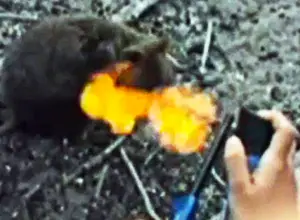
Photo: A man setting fire to a quokka
Quokkas are sometimes the target of mistreatment and cruelty by humans. Recently, two tourists ignited an aerosol mister that burned a quokka's fur. The perpetrators were fined $4,000 and imprisoned for their actions. In 2017, a man was videoed kicking a quokka multiple times; he too was fined $4,000. In yet another case, a man threw a quokka into the sea. Luckily, the distressed animal swam ashore safely. The man claimed in court that he merely "placed" the quokka in the water and didn't actually throw it in. The judge fined him $2,000. The maximum penalty for animal cruelty is a $50,000 fine and five years in jail.
Do Quokkas have Predators?
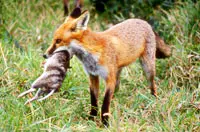
Photo: Red fox with prey
The natural predators of quokkas are birds of prey, goannas, snakes, and introduced animals such as dingoes, foxes, dogs, cats, and feral pigs. Quokkas on the remote offshore islands of Rottnest Island and Bald Island are strictly protected and have no native predators. The primary threat to quokkas on these islands is misplaced human kindness and occasional cruelty. Feeding quokkas "human food" can affect their digestion and make them dependent on human largess.
Why Quokkas Survive on Rottnest & Bald Islands
The Rottnest and Bald islands were separated from the mainland of Australia by the oceans about 6,000 to 8,000 years ago due to a rise in sea level. This was before the arrival of introduced animals such as the dingo, fox, feral pigs, cats and dogs to Australia. Fortunately, these predators could not swim to these islands. Hence, the quokka was protected.
Cats were once introduced by European settlers to these islands, but they have since been eradicated.
How the Quokka Almost Became Extinct
Quokkas have almost been pushed to extinction in recent years. Fossil records show that their range once covered an expanse of 41,000 square kilometres in south-western Western Australia, and they were widespread when the first European settlers arrived in the region in 1829. However, by the 1930s, the quokka population had decreased drastically due to hunting and poisoning by humans. The introduction of the red fox in the 1930s brought about a catastrophic decline in the number of quokkas on the mainland and brought them to near extinction.
Are Quokkas Endangered?
Quokkas are classified as a vulnerable species, and they will face extinction unless protected. The quokka population is approximately 10,000-12,000 quokkas on Rottnest Island and less than 1,000 in the south-western parts of Western Australia.
You cannot own or keep a quokka as a pet. It is illegal.
How Did the Quokka Get Is Name?
The quokka got its name from the local Aboriginals who referred to these as ‘quak –a’ and ‘kwoka’. So Europeans started calling this animal a ‘quokka’. The quokka is also known as the short-tailed scrub wallaby. Its scientific name is Setonix brachyurus.
How Rottnest Island Got Its Name
Rottnest Island is a 19sq kilometre island off the coast of Western Australia, near the present-day city of Freemantle. In 1658, Samuel Volckertzoon, the captain of the Dutch sailing ship Waeckende noted in his journal that he saw a wild cat resembling a civet cat with browner hair. He was the first European to record the sighting of a quokka. In 1696, Willem de Vlamingh, another Dutch sailor, explored the same island and described the island as overrun with 'rats the size of cats'. He named the island "Rotte nest", meaning rat's nest. This name eventually evolved into the island's present name of Rottnest Island.
25 Quokka Facts
- Quokkas are small hopping marsupials.
- Quokkas are best known for their cute, smiley faces.
- Actually, they are not smiling at you. It's just the way their mouths are shaped.
- Quokkas weigh between 2.5- 5 kilos and are 40 to 54 centimetres in length. They are roughly the size of a large cat.
- There are only about 13,000 quokkas in the wild.
- They are found mainly on Rottnest Island, off the coast of Western Australia.
- And they are mostly extinct elsewhere.
- Quokkas prefer moist conditions with dense scrubland.
- They feed on leaves and the soft shoots of woody plants.
- Because of the food sources available on Rottnest Islands, they have adapted to eating succulents and grasses.
- Quokkas eat by biting off a piece of vegetation, stuffing it into their mouths and swallowing it.
- They regurgitate it later, chew it thoroughly and swallow it once more.
- They need very little water to survive.
- Quokkas can climb small trees. Most other macropods can't.
- A baby quokka is called a joey.
- It is smaller than a grain of rice when born.
- It crawls up into its mother's pouch and grows there for six months or so.
- A quokka mother may sometimes discard the baby in her pouch when fleeing a predator.
- Quokkas live for about 10 years.
- The name quokka originated from the native Aboriginal name gwaga or kwaka.
- Quokkas face the threat of extinction.
- It is illegal to touch or feed a quokka.
- Quokkas are quite harmless.
- But have razor-sharp teeth and sharp claws.
- They can bite and scratch if frightened.